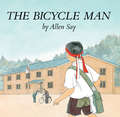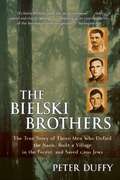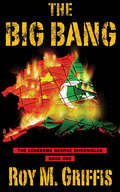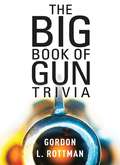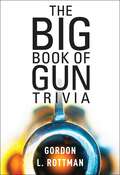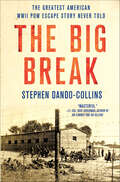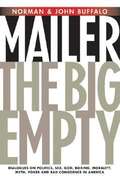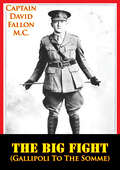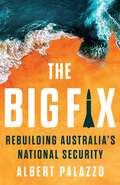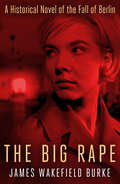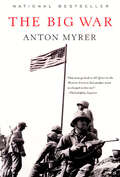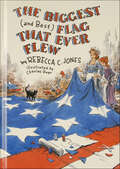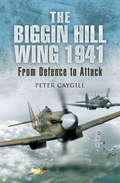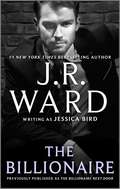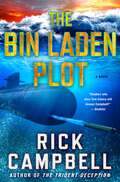- Table View
- List View
The Bicycle Man
by Allen SayThe amazing tricks two American soldiers perform on a borrowed bicycle are a fitting finale for the school sports day festivities in a small village in occupied Japan.
The Bicycle Runner: A Memoir of Love, Loyalty, and the Italian Resistance
by G. Franco RomagnoliG. Franco Romagnoli'sThe Bicycle Runner is an irresistible memoir of coming of age, friendship, love, and war during the perils of Fascist Italy.Like all boys growing up in Rome during the 1930s and 1940s, the author was expected to join the Balilla—Italy's fascist Youth Organization. With political divisions running deep in the families within his palazzo, he and his motley group of friends were recruited into the underground Resistance. Racing around Rome on bicycles, they smuggled messages and weapons for the partisans. Later, the author fled to the Italian countryside and narrowly avoided German mop-up operations—despite being sold out by his most trusted of friends. But this is much more than a war story. Lyrical in language, rich in sentimentality, and possessing the magic of a classic Fellini film, Romagnoli's memoir is a charmingly told tale of the search for manhood and the bonds of family and friendship.
The Bicycle Spy
by Yona Zeldis McdonoughMarcel loves riding his bicycle, whether he's racing through the streets of his small town in France or making bread deliveries for his parents' bakery. He dreams of someday competing in the Tour de France, the greatest bicycle race. But ever since Germany's occupation of France began two years ago, in 1940, the race has been canceled. Now there are soldiers everywhere, interrupting Marcel's rides with checkpoints and questioning. Then Marcel learns two big secrets, and he realizes there are worse things about the war than a canceled race. When he later discovers that his friend's entire family is in imminent danger, Marcel knows he can help -- but it will involve taking a risky bicycle ride to pass along covert information. And when nothing ends up going according to plan, it's up to him to keep pedaling and think quickly. . . because his friend, her family, and his own future hang in the balance.
The Bielski Brothers: The True Story of Three Men Who Defied the Nazis, Built a Village in the Forest, and Saved 1,200 Jews
by Peter Duffy<p>In 1941, three brothers witnessed their parents and two other siblings being led away to their eventual murders. It was a grim scene that would, of course, be repeated endlessly throughout the war. Instead of running or giving in to despair, these brothers - Tuvia, Zus, and Asael Bielski - fought back, waging a guerrilla war of wits against the Nazis. <p>By using their intimate knowledge of the dense forests surrounding the Belarusan towns of Novogrudek and Lida, the Bielskis evaded the Nazis and established a hidden base camp, then set about convincing other Jews to join their ranks. As more and more Jews arrived each day, a robust community began to emerge, a "Jerusalem in the woods." <p>After two and a half years in the woods, in July 1944, the Bielskis learned that the Germans, overrun by the Red Army, were retreating back toward Berlin. More than one thousand Bielski Jews emerged - alive - on that final, triumphant exit from the woods.</p>
The Big Bang
by Roy M GriffisIn this page-turning post-apocalyptic thriller, Roy M. Griffis explores an alternate timeline in which America falls victim to a coordinated attack by Islamic jihadists and Chinese Communists. It's 2008 and George W. Bush is still president. Three years later, the man called "Lonesome George" is in hiding, leading the resistance from a secret location. Multiple plot lines skillfully braid the tales of resistance fighters in various parts of the country. Whistler is the hard-bitten commander of a military unit in Texas. Karen, a former congressional aide, stumbles through the radioactive rubble of Washington DC. Molly, a leftwing columnist in San Francisco, finally puts her talents to good use on the underground radio as the voice of the resistance. Alec, a famous Hollywood actor, loses his wife and daughter in the nuclear attack on Los Angeles and becomes a legendary fighter, inventing the gun that bears his name. A vivid imagining of an America gone horribly wrong, written in gripping detail.
The Big Book of Civil War Sites: From Fort Sumter to Appomattox, a Visitor's Guide to the History, Personalities, and Places of America's Battlefields
by James C. BradfordThe definitive travel reference for America's most famous—and infamous—Civil War battle sites!With The Big Book of Civil War Sites, history-focused travelers finally have ready access to in-depth and thorough listings of all sites associated with the major battles of a devastating war that transformed the nation. Whether for exploring the Southern states or the Eastern theater, this book provides a full range of historical background information, travel and lodging options, museums, tours, and special events.Top attractions in the North include the National Civil War Museum in Harrisburg, Pennsylvania; Gettysburg National Military Park; and Harpers Ferry National Historical Park. In the Southern states—from the Outer Banks of North Carolina to the Mississippi Delta—readers will discover the fascinating and varied world of Civil War history and read detailed accounts of battles in North and South Carolina, Tennessee, Georgia, Alabama, Mississippi, Florida, and Louisiana.The Big Book of Civil War Sites includes:* Thorough listings of all major sites, including historical background information * Full-color photographs throughout* Special features on military and civic leaders * A glossary of Civil War terminology* Directions to hard-to-find locations* Helpful listings of restaurants, lodgings, shopping, tours, and special events
The Big Book of Gun Trivia
by Gordon L. RottmanThe Big Book of Gun Trivia: Everything you want to know, don't want to know, and don't know you need to know
The Big Book of Gun Trivia
by Gordon RottmanA complete guide to weapons history, facts, myths and trivia, covering everything you wanted to know, didn't want to know, and don't know you need to know... Gordon Rottman offers a step by step guide through interesting gun facts and statistics, including a section on ammunition, while breaking apart popular myths and misconceptions. Covering subjects from weapons designations to the longest serving military rifles, where rifles get their names from, and everything in between, Osprey is proud to present The Big Book of Gun Trivia.
The Big Breach: From Top Secret to Maximum Security
by Richard TomlinsonRichard Tomlinson was recruited by MI6, the British foreign intelligence service, during his senior year at Cambridge University. He quickly gained the trust and confidence of one of the world's most effective intelligence organisations. MI6 relied on Tomlinson to smuggle nuclear secrets out of Moscow, to run an undercover operation in Sarajevo while the city was under siege, and to infiltrate and dismantle a criminal group that sought to export chemical weapons capabilities to Iran.
The Big Break: The Greatest American WWII POW Escape Story Never Told
by Stephen Dando-CollinsThe story opens in the stinking latrines of the Schubin camp as an American and a Canadian lead the digging of a tunnel which enabled a break involving 36 prisoners of war (POWs). The Germans then converted the camp to Oflag 64, to exclusively hold US Army officers, with more than 1500 Americans ultimately housed there. Plucky Americans attempted a variety of escapes until January, 1945, only to be thwarted every time.Then, with the Red Army advancing closer every day, camp commandant Colonel Fritz Schneider received orders from Berlin to march his prisoners west. Game on! Over the next few days, 250 US Army officers would succeed in escaping east to link up with the Russians - although they would prove almost as dangerous as the Nazis - only to be ordered once they arrived back in the United States not to talk about their adventures. Within months, General Patton would launch a bloody bid to rescue the remaining Schubin Americans.In The Big Break, this previously untold story follows POWs including General Eisenhower's personal aide, General Patton's son-in-law, and Ernest Hemingway's eldest son as they struggled to be free. Military historian and Paul Brickhill biographer Stephen Dando-Collins expertly chronicles this gripping story of Americans determined to be free, brave Poles risking their lives to help them, and dogmatic Nazis determined to stop them.
The Big Empty: Dialogues on Politics, Sex, God, Boxing, Morality, Myth, Poker, and Bad Conscience in America
by Norman Mailer John Buffalo MailerSet against the backdrop of George W. Bush's re-election campaign and the war in Iraq, John asks his father to look back to World War II and explore the parallels that can and cannot be drawn between that time and our current post-9/11 consciousness.
The Big Fight (Gallipoli To The Somme) [Illustrated Edition]
by Captain David Fallon M.C.Includes the First World War Illustrations Pack - 73 battle plans and diagrams and 198 photos"Gallipoli and the Western Front to the end of 1916, as experienced by the author who served with the Australians and 1/Buckingham Bn of the O&B LIThis book is an account of the author's battlefield experiences at Gallipoli and on the Western Front. Fallon was a pre-war regular (Northumberland Fusiliers) who, when war broke out, was a staff sergeant instructor at the Australian Royal Military College in Duntroon. Transferred in some unexplained fashion to the Australian army he took part in the Gallipoli landings on 25 April 1915, which he describes in gory detail, as he does the rest of the fighting till he was evacuated in December. Back in the British army he was commisioned into the Buckingham Battalion (TF) of the O & B LI (145th Bde/48th Division) with which he fought on the Western Front till badly wounded at the end of 1916. He seems to go out of his way to make his descriptions of the fighting as bloody as possible, and as for the Germans, he has a chapter entitled "Hun Beastliness" in which he makes unbelievable statements such as the two examples which follow: It was the nude body of the Mother Superior. She had been nailed to the door. She had been crucified. In the ruins we brought out the bodies of four nuns, unspeakably mutilated. Their bodies had been stabbed and slashed each more than a hundred times. They had gone to martyrdom resisting incredible brutes. They had fought hard, the blond hair of their assassins clutched in their dead hands. And again, at Wytschaete: Above the wreck of the skyline trench bayonets stuck up, and on them were the severed heads, with horrible smiles under their English caps, of twenty of my men. Referring to German soldiers he writes: They hate the bayonet. The cold steel is not for Hans. Shades of Dad's Army, Lcpl Jones and "They don't like it up 'em"."-Print ed.
The Big Fix: Rebuilding Australia's National Security
by Albert PalazzoThe character of war is constantly changing, and so too must the approach to national security. But Australia&’s defence policy is broken. Successive governments have not approached the nation&’s security with the intelligence, resoluteness and seriousness it requires. After more than 120 years of defence policy centred on dependency, the geopolitical situation demands new thinking by politicians and policymakers to secure the nation for the future. In light of technological progress, the shifting balance of power in the Pacific and the worsening danger of climate change, Australia needs a new approach in order to charts its own course. In The Big Fix, defence strategist Albert Palazzo proposes a defence policy centred on the strategic defensive, which presents the best military fit for Australia, given its geography and the current state of military technology. Crucially, he elevates climate change to primacy in the national security hierarchy and explains how we cannot afford to ignore it as a security factor. And he asks: what is stopping Australia&’s leaders from seriously considering other options for the nation&’s security?
The Big Game (Star Trek: Deep Space Nine #4)
by Sandy SchofieldWhen Quark holds a poker tournament on Deep Space NineTM someone from almost every sentient race -- Klingons, Cardassians, Romulans, Vulcans, Ferengi -- shows up for what is sure to be the highest-stakes game of all time. But when one player is killed, the stakes get higher than even these big-money players had counted on. With the station rocked by subspace waves that threaten its destruction, Commander Sisko and Security Chief Odo must hunt down the killer in time to save the players, a killer who has information that can save those onboard Deep Space Nine from the invisible enemy they do not even know they face, a killer who holds all the cards...
The Big L: American Logistics in World War II
by Alan GropmanAmerican logistics in World War II was “big” by just about any measure one can devise. There is no question that it played a dominant role in the allied victory and thereby shaped the history of the rest of the century. The lessons of that achievement, consequently, remain essential today, especially for those who study and work with the resources component of United States grand strategy. So it is important that those lessons be accurate, that they portray a balanced view, pointing out shortcomings as well as documenting great successes; otherwise, a mythologized picture of the “Arsenal of Democracy” may be perpetuated. It was in this spirit that the Industrial College of the Armed Forces convened a symposium to address the lessons of World War II logistics—”the Big L.” The extended essays published here began as papers delivered at the symposium, then were expanded and revised for this book. Written by faculty of the Industrial College, they address the massive subject from seven perspectives: industrial mobilization; acquisition of war materials; the economics of mobilization; the building of infrastructure; the Lend-Lease program; joint logistics in the Pacific Theater; and joint logistics—the “materiel battle “—in Europe. The American effort—mind-boggling as it was in sheer numbers—was flawed in many respects. With the advantage of hindsight, the authors take a hard, unsentimental look at these areas of WWII logistics and offer a balanced analysis that will best serve our understanding of this subject.
The Big Lie: A True Story
by Isabella LeitnerThe Pulitzer Prize–nominated author recounts her Holocaust experience—her imprisonment at Auschwitz and her dramatic escape—in this book for young readers. As World War II rages in Europe, the fighting seems far away from Isabella Leitner and her family. Only rumors of Nazi horrors have reached them, and they feel safe in the small Hungarian town of Kisvarda. That is, until March 20, 1944 . . . Overnight, Isabella&’s whole world changes. Suddenly, she must wear a yellow star, be inside by curfew, and cannot go back to school. And that&’s only the beginning. Her family is rounded up by Nazi soldiers. They are put in cattle cars and taken to Auschwitz, a death camp in Poland. Only Isabella and three of her sisters are kept together, the rest of their family is forced to separate parts of the camp. Together, the four girls face their worst fears—until they get a chance at freedom. The Big Lie offers a look at history through the eyes of a woman whose strength and hope helped her overcome the worst of human nature. Leitner&’s &“approach allows readers to appreciate the young Isabella&’s incomprehension of the Final Solution even as she generates a coherent and compelling narrative&” (Publishers Weekly).
The Big Rape
by James Wakefield BurkeThe Big Rape, was first published in 1952 by Esquire's war correspondent James Wakefield Burke (1904-1989). The book, historically accurate in terms of place and events, is a fictional account of a German woman – Lilo Markgraf – in Nazi Germany, and traces the fall of Berlin to the Russians, and the subsequent widespread rape and debauchery the Red Army soldiers inflicted on the populace. At first, Lilo is an ardent nationalist and in love with a German soldier, but following the rape of her mother and her younger sister by Russian soldiers, Lilo returns from a small town to Berlin to attempt her revenge. She later becomes the mistress of a Soviet NKVD officer, taking advantage of the protection and benefits he can provide her. Finally, with the coming of the Americans in their occupied portion of Berlin, she attempts to plan her future.
The Big Ships Are Coming!
by Bill BeckerA novel about the liberation invasion of Guam in 1944, as seen through the eyes of a ten-year-old boy.
The Big Three: The United States, Britain, Russia (Routledge Library Editions: WW2 #2)
by David J. DallinThis book, first published in 1946, analyses the state of the world at the close of the Second World War. Global power was passing from Britain to the United States and the Soviet Union, with the US being involved in every part of the world, Russia dominant in eastern Europe and the world looked a very uncertain place. This survey of the main three powers examines their changing conditions and foreign policies.
The Big War
by Anton Myrer“One must go back to All Quiet on the Western Front to find another novel as charged as this one!” — Philadelphia InquirerNATIONAL BESTSELLER They were our husbands, our fathers, our lovers, our sons. They were Americans and Marines. And this is their story: The Big War, Anton Myrer's panoramic novel of Marines in the Pacific in World War II. This is the story of Alan Newcombe, the Boston society Harvard man; Danny Kantaylis, the natural-born leader; Jay O'Neill, the barroom scrapper. Myrer does not glorify war; he does not flinch from describing what the actual experience of warfare was like for a desperate group of Marines trapped in some of the worst fighting conditions of the war. We learn about their lives at home and their fates on the battlefield.
The Big Yankee: The Life Of Carlson Of The Raiders (The\elite Unit Ser. #36)
by Michael BlankfortIncludes 12 IllustrationsThis biography is the story of one of the most impressive figures to emerge from World War II. Evans F. Carlson is a living war hero who has won a place in the hearts of thousands of Americans through his courage, his humanity, and his grasp of the issues of war and peace. It is the story of Carlson the soldier and of Carlson the great American who has struggled against prejudice, complacency and ignorance to realize his vision of democracy in our military organizations and in the world at large.Here is the picture of the magnetic military leader who built up the revolutionary Raider Battalion on the principles of "Gung-Ho" and led it into the first land encounter with Jap forces. But underneath the superefficient soldier and planner of battles is the American looking for a way to fulfill the promise of our tradition. Carlson was raised in New England; he ran away from home, entered the Army, was sent to Europe, learned about guerilla warfare in Nicaragua and Asia. His first visit to China opened his eyes to the struggle men were still making to achieve democracy. He lived and fought with the Eighth Route Army. He tried to tell the world what he had learned about military democracy and the threat of Japanese fascism. Officialdom, however, was not ready for his message and he had to resign from the Marine Corps to bring his warning to the American people. Time proved his predictions true, and after 1941 he rejoined the Marines and organized the famous Raider Battalion, which put in practice what he had learned in China and all that he believed about American democracy.Michael Blankfort was in the Marine Corps himself and got to know Colonel (now Brigadier General) Carlson there. He has written this biography through this personal knowledge of Carlson and through conferences with his family and close friends and enthusiastic veterans who served with him.
The Biggest (and Best) Flag That Ever Flew
by Rebecca C. JonesYoung Caroline Pickersgill lives with her mother and grandmother in Baltimore, Maryland. Mrs. Pickersgill, a widow, supports herself and her daughter by making flags for the ships that sail into the city. Some soldiers from Fort McHenry come to her to order the biggest and best flag in the world, and Caroline helps make it. When the British sail up the Chesapeake Bay to destroy Baltimore during the War of 1812, the defenders at the fort beat them back. After the British sail away the next day, the flag “gallantly streaming” over the fort is the one Caroline and her mother had sewn. By “the dawn’s early light,” Francis Scott Key saw it waving “o’er the land of the free and the home of the brave.” Here is a charming (and true) children’s story about a young girl who, in helping her widowed mother, became a part of our nation’s history.
The Biggin Hill Wing, 1941: From Defence to Attack
by Peter CaygillAn in-depth study of England&’s most famous fighter station during the year of the Battle of Britain. The Biggin Hill Wing, 1941 looks at the political upheaval within Fighter Command that saw the removal of Sir Hugh Dowding and Keith Park and their replacement by Sir William Sholto Douglas and Trafford Leigh-Mallory. The ongoing Big Wing controversy and the resulting change in tactics during 1941 are examined. The main part of the book is a chronological account of the squadrons of the Biggin Hill Wing, with particular emphasis on the pilots. The units covered include No.s 66, 72, 74, 92, 124, and 609 Spitfire Squadrons and 264 Defiant Night Fighter Squadron. The author&’s research is based on combat reports and squadron Operation Record Books as well as firsthand accounts written by the participant pilots in the battles over southern England and northern France. Extensive appendices include Air Combat Claims of the Wing, Operational Aircraft Losses, Details of Selected Operations, and The Great Escape, which recounts the marked influence of ex-Biggin Hill pilots on the escape from Stalag Luft III in 1944.
The Billionaire (The O'Banyon Brothers)
by J. R. WardThis billionaire’s got it bad, and that’s not good… The first O’Banyon Brothers novel from New York Times bestselling author J.R. Ward writing as Jessica Bird. Originally published in 2007 as The Billionaire Next Door.Take-no-prisoners deal-maker Sean O’Banyon (aka SOB) eats Wall Street financiers for lunch. So why is he losing sleep over a sweet-faced nurse in old jeans and a too-big T-shirt? Maybe it’s those warm green eyes. Or the way she blushes when he gets personal. Maybe it’s the way she challenges everything he’s believed about himself for so long.There’s no denying they have serious chemistry. But sooner or later Lizzie will learn his deep, dark secrets. First, he has trust issues. Second, the whole family thing is not for him. And, last, he doesn’t do relationships—even if there’s something about Lizzie that makes him want everything he can’t have…
The Bin Laden Plot: A Novel (Trident Deception Series #7)
by Rick CampbellIn Rick Campbell's next technothriller, The Bin Laden Plot, a U.S. destroyer is torpedoed by an Iranian submarine and Captain Murray Wilson of the U.S.S. Michigan is flown to the Pentagon to meet with the Secretary of the Navy (SecNav).There Wilson learns that the Iranian submarine is just a cover story. One of the United States' own fully automated unmanned underwater vehicles has gone rogue, its programming corrupted in some way. Murray is charged with hunting it down and taking it out before the virus that's infected its operating system can infect the rest of the fleet. At the same time, the head of the SEAL detachment aboard the U.S.S Michigan is killed and Lonnie Mixell, a former U.S. operative, now assassin for hire, is responsible. And that is only the first SEAL to be hunted down and killed. Jake Harrison, fellow SEAL, discovers that these SEALs had one mission in common - they were all on the team that killed Bin Laden. Or so the world was told. As Wilson discovers that his mission is actually meant to cover up dangerous acts of corruption, even treason, Harrison discovers that the assassin is out to protect the same forces. Forces too powerful for either of them to take on alone.
